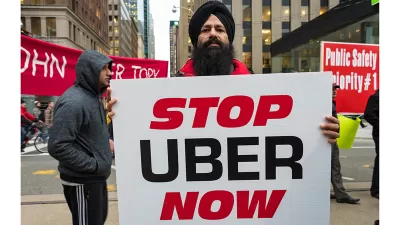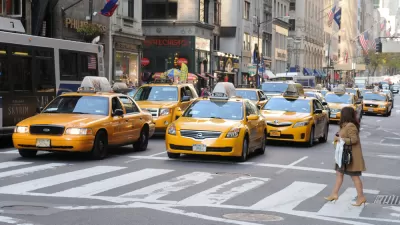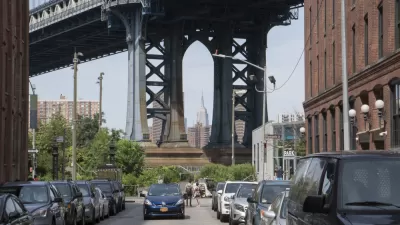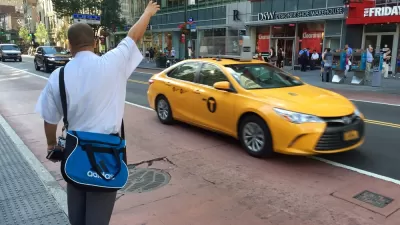Ride hailing seems to be here to stay, but if New York's mayor gets his way it will face a major speed bump in the Big Apple.

Mayor Bill de Blasio is looking to curb ride hailing in New York. "Since 2011, the number of for-hire cars on city streets has grown from 50,000 to 130,000, with 'the overwhelming majority' of the growth due to transportation network companies (TNC) like Uber and Lyft," Rachel Kaufman writes in Next City. Most of that growth has come from Uber and Lyft cars.
The New York City Council is currently considering three different bills that could discourage ride hailing. One would institute a $2,000 fee for every vehicle that operates for these services. The other two would cap the number of these vehicles that can operate in the city, according to Kaufman's reporting. "The proposed changes come on top of a $2.75 surcharge imposed by the state on all single-passenger e-hail rides in Manhattan below 96th Street," Kaufman writes.
FULL STORY: New York City Council Weighing Measures to Curb E-hailing Growth

Trump Administration Could Effectively End Housing Voucher Program
Federal officials are eyeing major cuts to the Section 8 program that helps millions of low-income households pay rent.

Planetizen Federal Action Tracker
A weekly monitor of how Trump’s orders and actions are impacting planners and planning in America.

Ken Jennings Launches Transit Web Series
The Jeopardy champ wants you to ride public transit.

Rebuilding Smarter: How LA County Is Guiding Fire-Ravaged Communities Toward Resilience
Los Angeles County is leading a coordinated effort to help fire-impacted communities rebuild with resilience by providing recovery resources, promoting fire-wise design, and aligning reconstruction with broader sustainability and climate goals.

When Borders Blur: Regional Collaboration in Action
As regional challenges outgrow city boundaries, “When Borders Blur” explores how cross-jurisdictional collaboration can drive smarter, more resilient urban planning, sharing real-world lessons from thriving partnerships across North America.

Philadelphia Is Expanding its Network of Roundabouts
Roundabouts are widely shown to decrease traffic speed, reduce congestion, and improve efficiency.
Urban Design for Planners 1: Software Tools
This six-course series explores essential urban design concepts using open source software and equips planners with the tools they need to participate fully in the urban design process.
Planning for Universal Design
Learn the tools for implementing Universal Design in planning regulations.
Ada County Highway District
Clanton & Associates, Inc.
Jessamine County Fiscal Court
Institute for Housing and Urban Development Studies (IHS)
City of Grandview
Harvard GSD Executive Education
Toledo-Lucas County Plan Commissions
Salt Lake City
NYU Wagner Graduate School of Public Service





























